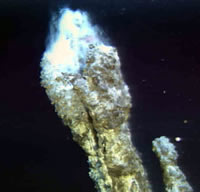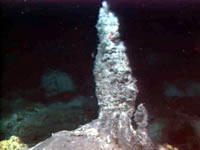| |
| |

Vixen Vent discovered on dive 627 at the
Coquille vent field.

Casper is the smaller of the two anhydrite spires found on dive R627,
at the Coquille vent field. Coquille (1536 meters) is a field that's
been around for some time and spans approximately 100 meters. |
|
Teacher Logbook - NOAA Ship Ron Brown
Thursday,
July 26, 2001
Bob Embley and Jeff Goodrich
Ship's position: Axial Volcano-Southern portion of caldera
Excitement
erupted last night in the ROPOS hydro lab as two new chimneys were discovered
in the Coquille vent field. While scouting around for a vent fluid sample
site we stumbled across two super-hot vents a few meters meters apart,
approximately one meter high. Both are believed to be anhydrite chimneys
and one had a temperature of 313 degrees Celsius, the hottest vent thus
far on the cruise. Taking a sample of the vent itself was not possible.
We didn't have anywhere to put it because the bio box was taken off so
that the hot fluid sampler could be installed for the dive. The chimney
material was too friable to be recovered in tact. Anhydrite, or calcium
sulfate, is more soluble in cold than hot water. Calcium sulfate in seawater
precipitates around the hot fluid flowing from the vent, forming a chimney.
If the chimney is removed and placed in cold seawater, it dissolves. This
is counter to metallic sulfide chimneys that are more soluble in hot water
and precipitate out when entering cold seawater. Without a sample of the
chimney itself, we settled on taking temperature and fluid samples for
chemical analysis.
These new
hot vents probably tap a deeper, more long-lived heat source beneath the
southern part of the caldera. Recent deep seismic work by Lamont-Doherty
Earth Observatory suggest that a large partly molten zone exists beneath
this part of the volcano. This new finding will help fill important gaps
in understanding the relationship of the different types of hydrothermal
activity to the deep structure of the volcano.
I found the
process of naming the new vents quite amusing. The scientists that happened
to be in the hydro lab just started throwing out ideas. Phantom, Demon,
Casper, Bliss, Vixen and BK Boiler were some that I recall. They finally
settled on Vixen and Casper. Verena Tunnicliffe stated it best after seeing
the new vents, "Why didn't we see them last year?" and "You
know, it's always a surprise out here." A half hour after finding
the vents all the monitors on the ROPOS console went blank. We had lost
power to the ROV. The ROPOS team remained calm and several minutes later
the problem, a blown fuse, was fixed. We were back on the bottom twenty
minutes later to finish up the dive.
|
|

